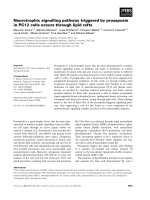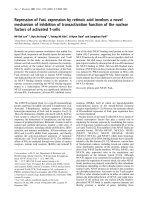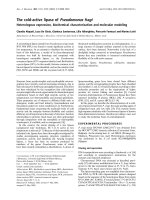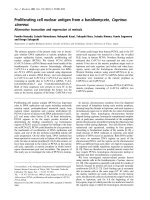Báo cáo y học: "gA retroperitoneal abscess caused by Haemophilus parainfluenza after endoscopic retrograde cholangiopancreatography and open cholecystectomy with a common bile duct exploration: a case report" ppt
Bạn đang xem bản rút gọn của tài liệu. Xem và tải ngay bản đầy đủ của tài liệu tại đây (353.92 KB, 3 trang )
JOURNAL OF MEDICAL
CASE REPORTS
Patel et al. Journal of Medical Case Reports 2010, 4:170
/>Open Access
CASE REPORT
BioMed Central
© 2010 Patel et al; licensee BioMed Central Ltd. This is an Open Access article distributed under the terms of the Creative Commons
Attribution License ( which permits unrestricted use, distribution, and reproduction in
any medium, provided the original work is properly cited.
Case report
A retroperitoneal abscess caused by
Haemophilus
parainfluenza
after endoscopic retrograde
cholangiopancreatography and open
cholecystectomy with a common bile duct
exploration: a case report
Shonak B Patel, Zubair A Hashmi* and Robert J Marx
Abstract
Introduction: Abscesses after open cholecystectomies have been reported to occur in less than 1% of patients. The
majority of these abscesses are colonized by gastrointestinal tract flora. It is clearly known that Haemophilus
parainfluenza is a normal inhabitant of the human respiratory tract. However, its origin and route of transmission into
the gastrointestinal tract is unknown.
Case presentation: We present the case of a 68-year-old Caucasian female who developed a retroperitoneal abscess
caused by H. parainfluenza after open cholecystectomy and common bile duct exploration. This presented nearly five
weeks post-operatively. She underwent a second operation to drain the abscess, and was subsequently placed on
appropriate antibiotics.
Conclusion: A retroperitoneal abscess due to H. parainfluenza is extremely rare. It is a normal inhabitant of the human
respiratory tract. To the best of our knowledge, there have been only a few reported cases of these abscesses, and they
mainly involve the psoas muscle. The retroperitoneal abscess originated from the oropharynx, most likely after the
endoscopic retrograde cholangiopancreatography was performed. With the advent of Natural Orifice Translumenal
Endoscopic Surgery, oral decontamination will need to be considered to decrease the potential for such infections.
Introduction
Haemophilus parainfluenza is generally regarded as a
commensal bacterium in the respiratory tract. It has been
known to provoke respiratory tract infections, otitis, and
meningitis. However, little is known about its ability to
colonize other sites. A search of the literature reveals only
one reported case of H. parainfluenza in the gastrointes-
tinal tract [1]. We now report a second case in which a
68-year-old presented with a retroperitoneal abscess due
to H. parainfluenza after open cholecystectomy and
common bile duct (CBD) exploration.
Case presentation
A 68-year-old Caucasian female with a history of hyper-
tension and hysterectomy (approximately 20 years ago)
presented to the hospital with dehydration and right
upper quadrant pain. A computed tomography (CT) scan
of our patient obtained as an out-patient showed irregu-
lar thickening of the gallbladder wall associated with
stones, but there was no evidence of cholecystitis. Both
the intrahepatic and extrahepatic biliary ducts were
dilated approximately to the level of the CBD, but indi-
cated no choledocolithiasis. A follow-up endoscopic ret-
rograde cholangiopancreatography (ERCP), performed to
evaluate for possible cholangiocarcinoma, revealed a
CBD stone with marked intrahepatic and extrahepatic
duct dilatation. ERCP indicated no evidence of a cholang-
iocarcinoma. After papillotomy, the endoscopist deter-
* Correspondence:
1
Northside Medical Center, Department of Surgery, 500 Gypsy Lane,
Youngstown, OH 44505, USA
Full list of author information is available at the end of the article
Patel et al. Journal of Medical Case Reports 2010, 4:170
/>Page 2 of 3
mined the stone was beyond the scope of endoscopic
removal, thus open cholecystectomy with CBD explora-
tion was indicated.
Two days later, our patient underwent an open chole-
cystectomy and CBD choledochoscopy with an Olympus
VRF Type P2™ flexible fiberoptic choledocoscope. A pro-
phylactic antibiotic, 1 g cefazolin, was given on induction
of anesthesia. The choledocolith was removed by chole-
docotomy performed on the palpable stone. A CBD T-
tube was placed, brought out through the lateral abdomi-
nal wall, and attached to the bile drainage bag. No other
stones remained in the CBD after the completion of sur-
gery, which was confirmed by intra-operative cholangio-
gram. The stone was assumed to have been present in the
CBD for many years since it was significantly large. The
possibility of it being a primary CBD stone or a stone that
was passed into the CBD years ago and continued to grow
also had to be entertained.
Five weeks post-operatively, our patient was readmitted
with dehydration and poor oral intake. The patient had
remained afebrile with white blood cell count of
15.1×10
3
k/mcL with no shift in white blood cell morphol-
ogy. A CT-scan was obtained and indicated a fluid collec-
tion suggesting an abscess of the right flank (figure 1).
Our patient was taken to the operating room where a ret-
roperitoneal abscess was found that tracked into the right
paracolic gutter and into the right flank. There was no
subhepatic fluid collection. The CBD repair was intact.
Multiple drains were placed in the abscess cavity. Cul-
tures of the collected fluid revealed H. parainfluenza. An
Infectious Disease specialist was consulted, and the
patient was placed on intravenous ceftriaxone (which was
susceptible to the organism) for 6 weeks. Follow-up
appointments and CT-scans at 6 weeks showed a
decrease in the fluid collection, and she denied any fur-
ther symptoms.
Discussion
A retroperitoneal abscess due to H. parainfluenza is very
rare. There have been only a few reported cases of these
abscesses, mainly involving the psoas muscle [2,3]. One
case reports a retroperitoneal abscess caused by H.
parainfluenza after ERCP [1]. According to Riahi et al.,
possible explanations for the abscess include infection
secondary to retroperitoneal perforation occurring dur-
ing sphincterotomy or introduction of the bacterium
from the upper airway during the ERCP and subsequently
to the retroperitoneal space via a perforation in the per-
formance of the sphincterotomy [1]. Our case also
involved ERCP with papillotomy, a possible port of entry
for the bacterium. The common duct stone was too large
(3 to 4 cm) to remove via ERCP; therefore an open chole-
cystectomy and CBD exploration was performed. If H.
parainfluenza was introduced during the ERCP, there
was no evidence of perforation or abscess and the CBD
was intact at operation. It is well understood that H.
parainfluenza is a common inhabitant of the mucosal
surfaces of the human upper respiratory tract [4]. There
is a possibility that the patient may have subsequently
coughed up and swallowed the H. parainfluenza, moving
it into the gastrointestinal tract and allowing it to track
back along the T-tube. Another possibility may be that H.
Figure 1 White arrows indicating retroperitoneal abscess.
Patel et al. Journal of Medical Case Reports 2010, 4:170
/>Page 3 of 3
parainfluenza, is a rarely identified bacterium found in
the intestinal tract of healthy patients, and seldom causes
problems until surgical manipulation allows it to manifest
as an abscess. Our patient had no other source of infec-
tion (upper respiratory, pneumonia, otitis, etc), nor did
the abscess grow any other organism other than H.
parainfluenza.
Conclusions
Abscesses after open cholecystectomies have been
reported to occur in less than 1% of patients [5]. The
majority of these abscesses are colonized by gastrointesti-
nal tract flora [5]. H. parainfluenza is a normal inhabitant
of the human respiratory tract and its route of transloca-
tion into the gastrointestinal tract is largely unknown. We
postulate that, in this case, the H. parainfluenza found in
the retroperitoneal abscess originated from the orophar-
ynx and may have been introduced from the ERCP. We
conclude that investigations for H. parainfluenza should
be performed more often in relation to the intestinal
tract. With the advent of NOTES, or Natural Orifice
Translumenal Endoscopic Surgery, oral decontamination
[5] may need to be considered to decrease the potential
for such infections.
Consent
Written informed consent was obtained from the patient
for publication of this case report and any accompanying
images. A copy of the written consent is available for
review by the Editor-in-Chief of this journal.
Competing interests
We have nothing to declare or disclose. No competing interest to declare.
Authors' contributions
SP carried out the search and obtained data on H. parainfluenza, and cross ref-
erenced its occurrence to extra-respiratory infections, assisted in compiling the
manuscript, and also carried out chart review, as well as obtaining images. ZH
carried out the search and obtained data on H. parainfluenza, and cross refer-
enced its occurrence to extra-respiratory infections, assisted in compiling the
manuscript, and also carried out chart review, as well as obtaining images. RM
provided the editing, along with assisting in compiling the manuscript. SP, ZH,
RM were all directly involved in both operations, as well as the post-operative
care and management of the patient. All authors have read and approved the
final manuscript.
Author Details
Northside Medical Center, Department of Surgery, 500 Gypsy Lane,
Youngstown, OH 44505, USA
References
1. Riahi S, Hansen J, Bjerre J, et al.: ERCP complicated by a retroperitoneal
abscess caused by Haemophilus influenzae and Haemophilus
parainfluenza. Gastroint Endosc 1998, 47:417-418.
2. Laing RBS, Leen CLS, Watt B: Haemophilus parainfluenza: an unusual
case of psoas abscess. Case report. Infection 1995, 23:361-362.
3. Davies D, King SM, Parekh RS, et al.: Psoas abscess caused by
Haemophilus influenzae type B. Pediatr Infect Dis J 1991, 10:411-412.
4. Megraud F, Bebear C, Dabernat H, et al.: Haemophilus species in the
human gastrointestinal tract. Eur J Clin Microbiol Infectious Dis 1988,
7:437-438.
5. McAneny D: Open cholecystectomy. Surg Clinics N Am 2008,
88:1273-1293.
doi: 10.1186/1752-1947-4-170
Cite this article as: Patel et al., A retroperitoneal abscess caused by Haemo-
philus parainfluenza after endoscopic retrograde cholangiopancreatography
and open cholecystectomy with a common bile duct exploration: a case
report Journal of Medical Case Reports 2010, 4:170
Received: 21 September 2009 Accepted: 3 June 2010
Published: 3 June 2010
This article is available from: 2010 Patel et al; licensee BioMed Central Ltd. This is an Open Access article distributed under the terms of the Creative Commons Attribution License ( ), which permits unrestricted use, distribution, and reproduction in any medium, provided the original work is properly cited.Journal of Medical Case Reports 2010, 4:170









